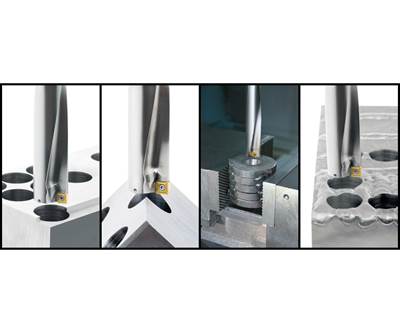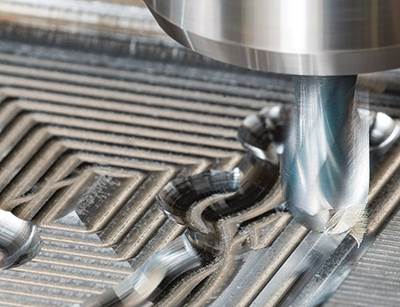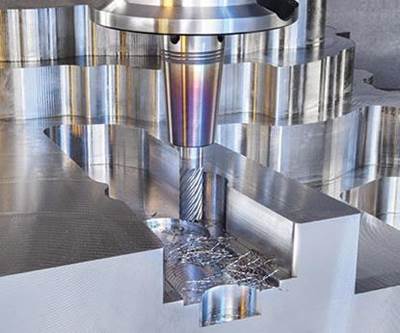Faster Cornering in Cavity Hogging Boosts Capacity
With a cutter capable of plowing through the corners at full speed, a Michigan moldmaker says it has doubled rough-milling throughput, freeing up machine time for mechanical polishing instead of tedious handwork.
You may still believe it’s necessary to back off the feed rate at every corner when rough-milling a cavity, but Dura Mold Inc. in Stevensville, Michigan, knows otherwise.
With a cutter capable of plowing through the corners at full speed, Dura Mold says it has doubled rough-milling throughput on a light-duty, 40-taper CNC machine, and that has freed up enough machine time to do more of the polishing by machine, saving hours and hours of tedious handwork. Retooling with the Ingersoll Hi-Feed Mini milling cutter also tripled edge life on wrought and hardened H13 mold stock from three hours to nine hours per edge, the company says. Overall, total costs for cavity roughing dropped 70 percent with this one simple tooling switch.
“We were looking only for better tool life and wound up with a ripple effect that basically boosted mold production capacity and gave us a marketing edge in delivery,” says Tim Pazder, Dura Mold purchasing agent. His 60-person shop builds die-casting and plastic injection molds for a variety of markets, including appliances and medical equipment.
Heavy Going on a Light-Duty Machine
Dura Mold roughs most mold cavities on a 40-taper Akira Seiki three-axis CNC machining center, a relatively light-duty machine for roughing mold stock. Prior to the retooling, its standard settings on H12 mold stock in the wrought condition were 350 sfm, 85 ipm and 0.025-inch depth of cut with a 60-percent stepover. For hardened stock, the depth of cut was 0.015 inch with 40-percent stepover and unchanged feed and speed. At these settings, cutting edges typically lasted about three hours in the cut, the company says. Running any faster cut severely into tool life and sometimes caused chatter as soon as the edge began to show flank wear. Also, trying to run full speed through the corners, where there is more “wraparound,” raised the risk of chip jamming and tool fracture.
Last January, plant manager Scott Purcell asked Ingersoll field engineer Kendall Smith for a solution to the tool-wear problem. Smith recommended the Hi-Feed Mini face mill, which he said was proven in other mold shops to improve efficiency as well as edge life. However, the switch would be more involved than drop-in retooling if Dura Mold wanted to get maximum benefit, Smith warned. “It would mean some reprogramming of the tool path to eliminate the slowdowns in corners as well as the usual resetting of parameters,” he said.
In trials with the cutter, edge life improved by a ratio of more than 6-to-1 when running under Dura Mold’s then-standard settings, including the slowdowns in the corners. That met the company’s original goal to reduce tooling costs. One contributor to this improvement was the fact that the face mill’s two-sided inserts provide twice the edges per insert as the previous cutter.
Full-Speed Cornering
At Smith’s urging, Dura Mold also modified the toolpath programs so the cutter would move through the corners a little faster. Throughput increased substantially with only minor loss of edge life, the shop says. With that reassurance, the program was further modified to the point that the cutter was able to chew through the corners with no slowdowns at all. The final settings the company arrived at were 280 ipm, 475 sfm and 0.025-inch depth of cut with the same 60-percent stepover as before. This represents a fivefold increase in feed rate in the corners as well as the straightaways. In addition, despite the higher material-removal rate, the inserts lasted three times longer, at nine hours per edge versus three, Purcell says.
Once the process was validated, it didn’t take long for his team to capitalize on the freed-up machine time in two different ways. First was a move toward machine polishing, which is considered much more consistent and cost-effective than handwork. Soon after, Dura Mold also turned up its marketing efforts, stressing faster delivery.
Pushing the Envelope
Dura Mold says the Hi-Feed Mini has become the standard for roughing cavities in both die-casting and plastic molds made of H13 mold stock, both wrought and hardened. It makes a bigger difference on die-casting molds, because the cavities are deeper on average. The shop’s first job using the face mill was a 12-cavity mold to produce two different parts. The order included the mold block plus 24 mold inserts, including spares. The company planned to ship in a month but says it had it out the door in two weeks, largely because the cavity hogging went so quickly.
Dura Mold stocks both 2-inch and 1-inch sizes of the cutters to match applications. With the 2-inch tool, it has completed long-reach milling in cavities ranging to 14 inches deep at the same material-removal rates and with the same edge life as on a shallower cut, and with no chatter, the shop says. It says it has also successfully machined the more challenging H11 stock in the wrought condition with the Hi-Feed Mini and is developing a process to machine hardened H11 as well.
Dura Mold puts estimated total savings from the retooling at nearly $100,000 per year, nearly half of it in maintenance, repair and operating costs. “Triple the edge life, twice the edges per insert. It adds up quickly,” Purcell says.
According to Smith, eliminating slowdowns in the corners alone probably contributed more than 25 percent to the higher removal rate. “Cornering slowdowns can be real ‘time bandits’ in cavity hogging,” he says.
See such high-feed geometry in action by clicking HERE.
Related Content
Treatment and Disposal of Used Metalworking Fluids
With greater emphasis on fluid longevity and fluid recycling, it is important to remember that water-based metalworking fluids are “consumable” and have a finite life.
Read MoreHow to Eliminate Chatter
Here are techniques commonly used to combat chatter and guidelines to establish a foundation for optimizing the moldmaking process.
Read MoreForces and Calculations Are Key to Sizing Core Pull Hydraulic Cylinders
To select the correct cylinder, consider both set and pull stroke positions and then calculate forces.
Read MoreFundamentals of Designing the Optimal Cooling System
The right mold components can help improve mold cooling and thereby produce higher-quality parts.
Read MoreRead Next
Take the Plunge: Drill vs. Mill
Strategic operation planning and cutting tool system optimization can make plunge roughing a productive, stable choice for high-volume material removal.
Read MoreMaximize Hard Milling with Balanced Machining Process Factors
Successful application of high-speed milling of hardened steels requires an understanding of the many factors that influence the entire machining process.
Read MoreRough Milling: Speed vs. Power
A look at what works in rough milling applications with solid carbide end mills.
Read More
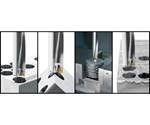
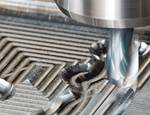





_300x250 1.png;maxWidth=300;quality=90)














